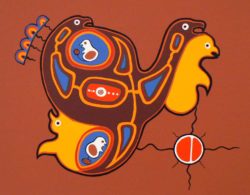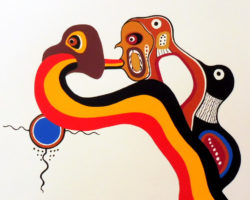Jackson Beardy
Jackson Beardy, an Ojibway artist, was a leading Native figure in the late 1960s and 1970s, advocating both politically and artistically for the rights of the peoples of the First Nations in Canada. As a founding member of the New Woodland School and as a community representative on various cultural and political organizations, Beardy forged a path and created a legacy of activism for those who followed. Beardy's influence on the revitalization of Woodland culture and the policies and methods of Canadian institutions handling and interpreting art treasures of First Nations has been an important contribution to the development and history of the art of the First Nations.
Treaty Numbers 23, 287, 1171 was one of the first exhibitions in Canada to address First Nations art within an aesthetic as opposed to anthropological framework. The exhibition was curated by the late Jacqueline Fry for the Winnipeg Art Gallery in 1972 and included the work of Daphne Odjig, Alex Janvier, and Jackson Beardy. Appropriately, these artists would become associated with a move toward the application of new methodological approaches to native art in the 1970s that would continue to be refined and developed throughout the 1980s.
In the early 1970s, Odjig, Janvier, and Beardy actively advocated for the rights of Native artists through their formation of what was popularly called the Group of Seven with artists Norval Morrisseau, Carl Ray, Eddy Cobiness and Joseph Sanchez. Through their association--professionally known as Native Artists, Inc.--these artists provided a much-needed informal but focused forum for criticism amongst artists. They organized exhibitions, worked toward the development of a scholarship program, developed strategies to inform the public about their work, and worked to control the production and marketing of their art. The Group of Seven hoped to encourage Native control of Native interests; separate their work from the established Indian art marketing program, which emphasized "Indianness"; and dispense with art-world arguments regarding the artistic versus anthropological significance of works of art by Native artists.
For Beardy, the Group of Seven was only the beginning. He would subsequently augment his career as an artist with the role of cultural activist, serving as art advisor and cultural consultant to the Manitoba Museum of Man and Nature, the Department of Native Studies at Brandon University, and the Department of Indian Affairs and Northern Development in Ottawa. He was also an active member of the National Indian Arts Council, the Manitoba Arts Council, the Prison Arts Foundation, Canadian Artists' Representation, Canadian Indian Artist Association, and a council member for the Garden Hill Band of Island Lake, Manitoba.
As a visual artist Beardy was a pivotal figure during his lifetime and has become emblematic of a style, period, and movement. As one of the founding members of the New Woodland School, and as part of the founding generation of modern Native artists in Canada, Beardy was one of the first to wed Ojibway tradition with European notions of fine art. His art is representative of the New Woodland School style: iconic figures, an undifferentiated background, systems of linear determinatives, x-ray perspectives, and vibrant unmixed hues. With cultural specificity, it reflects his search for "a visual symbolic language that would convey a cohesive world view," as Colleen Cutschall described it in 1994. Beardy created an art of profound cultural change--steeped both in a traditional heritage and a contemporary reality and relevance. His work is powerful in its historical, cultural and political significances.
Throughout his lifetime, Jackson Beardy's social work traversed cultures, instigated change, marked the combined aesthetic/political intersection that would ensure the activity of a second generation of Native "modernists." In 1972, Jackson Beardy was awarded the Canadian Centennial Medal, and in 1984 his memorial service was the first ever held in the Blue Room of the Manitoba Legislative Buildings. Here federal, provincial, and civic leaders joined Beardy's family and Native leaders and elders in mourning Beardy and paying tribute to his life and work.
1944 - 1984
Nationality: Ojibway
Occupation: Artist, Painter, Illustrator
PERSONAL
Born: Garden Hill Reserve, Island Lake, Manitoba, 24 July 1944. Education: Technical Vocational School, Winnipeg, Manitoba, 1963-1964; School of Fine Arts, University of Manitoba, Winnipeg, 1966. Career: Commercial artist, Band Council member for the Garden Hill Band, Island Lake, Manitoba (elected), teacher, lecturer, field researcher; founding member, The Group of Seven, and the associated Native Artists Inc.; art advisor and cultural consultant, Manitoba Museum of Man and Nature, Department of Native Studies, Brandon University, and the Department of Indian Affairs and Northern Development, Ottawa. Member, National Indian Arts Council, Ottawa; Manitoba Arts Council, Winnipeg; Prison Arts Foundation, Ottawa; Canadian Artists' Representation, Ottawa; Canadian Indian Artist Association. Commissioned by the Canadian Catholic Conference of Bishops, 1975, St. John's College, University of Manitoba, mural, 1976, Manitoba Museum of Man and Nature, mural (The Great Chain of Being), 1978, City of Winnipeg, coin design, 1978, Province of Manitoba, painting presented to Queen Elizabeth II, 1979, City of Winnipeg, 1979, International Association for the History of Religion, painting presented to Crown Prince of Japan, 1980, Winnipeg Women's O.R. T. (Loons `81), painting, 1981. Awards: Canada Centennial Award, 1967; Canada Council Grant, 1982; Board of Directors, Manitoba Arts Council. Died: 1984.
WRITINGS:
INDIVIDUAL EXHIBITIONS
- 1965: University of Winnipeg, Manitoba
- 1967: United College, Winnipeg, Manitoba
- 1969: Royal Bank of Canada, Winnipeg, Manitoba
- 1970: National Arts Centre, Ottawa, Ontario
- 1976: Pollock Gallery, Toronto, Ontario
- 1977: Images for a Canadian Heritage, Vancouver, British Columbia
- 1977: Robertson Galleries, Ottawa, Ontario
- 1978: Fort Garry Trust, Winnipeg, Manitoba
- 1979: Gallery One, Toronto, Ontario
- 1979: Galerie Martal, Montreal, Quebec
- 1979: Children of the Raven Gallery, Vancouver, British Columbia
- 1980: The Raven Gallery, Minneapolis, Minnesota
- 1980: Robertson Galleries, Ottawa, Ontario
- 1980: Eaton's Fine Art Gallery, Winnipeg, Manitoba
- 1981: Images Gallery, Vancouver, British Columbia
- 1982: Rothwell Galleries, Ottawa, Ontario
- 1995: Jackson Beardy: A Life's Work, Thunder Bay Art Gallery, Ontario
SELECTED GROUP EXHIBITIONS
- 1967: Indian of Canada Pavilion, Expo '67, Montreal
- 1970: Manitoba Days, National Arts Centre, Ottawa
- 1972: Treaty Numbers: No. 23, 287, 1171, Winnipeg Art Gallery
- 1974: Canadian Indian Art '74, Royal Ontario Museum, Toronto
- 1974: Gallery Anthropas, London
- 1974: Merritt College, Oakland, California
- 1975: Wallack Galleries, Ottawa
- 1976: Contemporary Native Art of Canada: The Woodland Indians, Royal Ontario Museum, Toronto (traveled to England and Germany)
- 1976: Wells Gallery, Ottawa
- 1977: Native Graphics, Winnipeg Art Gallery
- 1977: Contemporary Indian Art: The Trail from the Past to the Future, MacKenzie Gallery and Native Studies Programme, Trent University, Peterborough, Ontario
- 1977: Links to a Tradition, Department of Indian and Northern Affairs for the Canadian Embassy in Brazil
- 1978: Merton Gallery, Toronto
- 1979: Indian Art `79, Woodland Indian Cultural Educational Centre, Brantford, Ontario
- 1980: Manitou Citizens' Bursary Fund for Native Peoples Show, Winnipeg
- 1980: Graphics Gallery, Ottawa
- 1982: Five Woodland Indian Artists, Raven Gallery, Minneapolis
- 1982: Renewal: Masterworks of Contemporary Indian Art from the National Museum of Man, Thunder Bay, Ontario
- 1982: Contemporary Indian Art at Rideau Hall, Ottawa
- 1983: -85 Contemporary Indian and Inuit Art of Canada, organized by the Department of Indian and Northern Affairs (traveling)
COLLECTIONS
- Canadian Museum of Civilization, Ottawa
- Department of Indian and Northern Affairs, Ottawa
- Department of Justice, Supreme Court, Ottawa
- Glenbow-Alberta Institute, Calgary
- Manitoba Museum of Man and Nature, Winnipeg
- McMichael Canadian Collection, Kleinburg, Ontario
- Mother Theresa's Hospital, Calcutta, India
- Royal Ontario Museum, Toronto
- Simon Fraser University, Burnsby, British Columbia
- University of British Columbia, Vancouver
- University of Wellington, New Zealand
- Winnipeg Art Gallery
- Windsor Castle, London.
One Language
Artist: Jackson Beardy
Medium: Serigraph (Silkscreen)
Size: 18 x 22 Inches
Code No.: JBS07
Price: $1,200.00
SOLD
Procreation
Artist: Jackson Beardy
Medium: Serigraph
Size: 18 x 22 Inches
Code No.: JBS12
Price: $950.00



